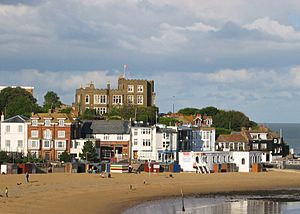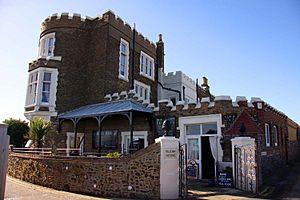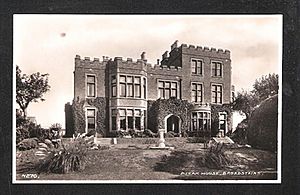Bleak House, Broadstairs facts for kids
Bleak House, first called Fort House, is a famous building in Broadstairs, Kent. It sits high on a cliff, looking out over the North Foreland and Viking Bay. The house was built around 1801. It became much bigger in 1901, doubling in size. Long ago, it was a coastal station. People used it to watch ships and activity at sea.
The famous writer Charles Dickens spent holidays at Fort House. He stayed there in the 1850s and 1860s. He wrote parts of his novel David Copperfield while living there. Some people also believe he wrote his book Bleak House at this very house. This is why its name changed to Bleak House in the early 1900s. The house is officially recognized as a historic building. It is listed as Grade II on the National Heritage List for England.
History of Bleak House

Bleak House was first known as Fort House. It was the home of a captain. This captain was in charge of one of the two forts that protected Broadstairs. These forts guarded the town from the coast.
Charles Dickens' Connection
Charles Dickens rented Fort House from the 1840s until 1852. He called it an "airy nest" above the harbor. It was here that he wrote his famous book, David Copperfield. Fort House got its new name, Bleak House, in the early 1900s. Someone claimed it was the house from Dickens' 1853 novel, Bleak House. The name then stayed.
There has been some debate about this claim. Some people think the house that inspired Dickens was far from Broadstairs. But one thing is for sure: Dickens loved this house. He said it was the home he "most desired" in Broadstairs. Broadstairs was his favorite holiday spot. The famous Danish author Hans Christian Andersen also visited often during this time.
In 1865, author William Carew Hazlitt wrote about the house. He said it was "the big, bleak house that stands alone on a peak of the chalk cliff." He described it as if it were a "sentinel set over the rovers up and down the sea."
For many years in the 20th century, Bleak House had two parts. One part was a private home. The other part was a museum about Charles Dickens. In 2012, the owners opened it as a place for weddings and a guest house. Since January 2021, it has new owners. It is now a private home again. The owners are working to make it look as grand as it once did.
Smuggling History
Broadstairs, like many towns along the English coast, had a history of smuggling. This was common in the 1700s and early 1800s. The house used to have a Smugglers Museum downstairs. However, the new owners of Bleak House have not reopened this museum.
External Links
- Blaze at Bleak House



